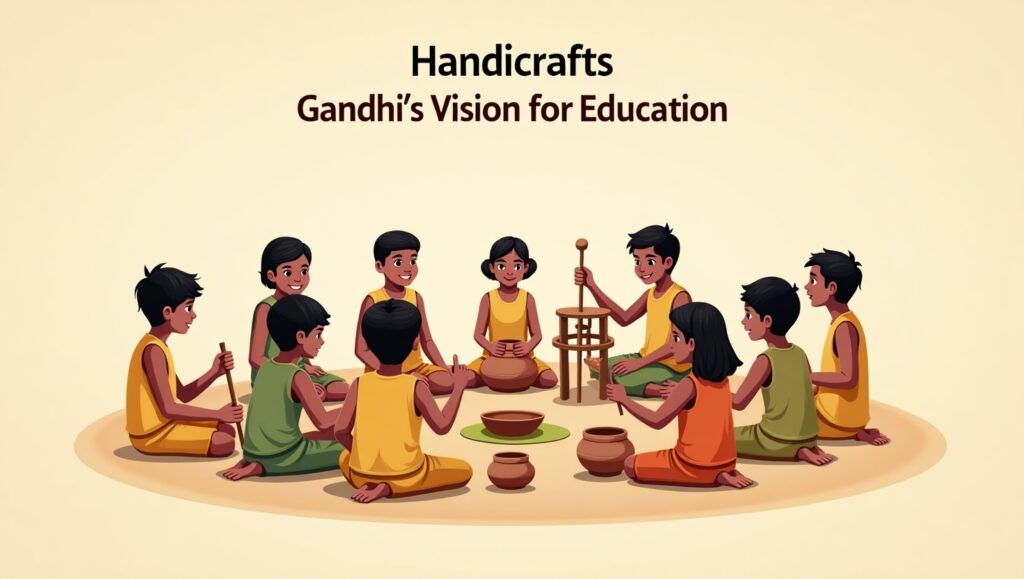Mahatma Gandhi, the Father of the Nation, was not only a political leader but also a visionary educator. He strongly believed that education should go beyond books and must prepare children for real life. One of his unique ideas was to teach children handicrafts as an essential part of their learning process.
At Subyaas.com, where we promote the value of authentic Indian handicrafts, we truly connect with Gandhiji’s vision. His philosophy continues to inspire us in preserving and promoting traditional crafts that are not only artistic but also deeply rooted in India’s culture.
Gandhi’s Philosophy of Education – Nai Talim

Gandhiji introduced the concept of Nai Talim (Basic Education) in 1937. His belief was that:
- Education should develop head, heart, and hand together.
- Children must learn to be self-reliant.
- Skills and knowledge should be connected to daily life and livelihood.
For Gandhi, teaching handicrafts was not just about making children learn a skill but about shaping their character, discipline, and independence.
Why Did Mahatma Gandhi Want to Teach Children Handicrafts?
There were several important reasons why Gandhiji wanted handicrafts to be part of children’s education:
1. Self-Reliance
Gandhi wanted every child to be self-reliant. Learning handicrafts like spinning, weaving, or carpentry would help children stand on their own feet and not depend only on bookish knowledge.
2. Respect for Labour
Gandhi believed in the dignity of labour. By teaching handicrafts, he wanted to remove the social stigma attached to manual work and make children respect every type of job.
3. Skill Development
Handicrafts give children practical skills that can help them earn a livelihood in the future. For Gandhi, education without skill was incomplete.
4. Character Building
Handicrafts teach patience, discipline, creativity, and responsibility. These values were central to Gandhi’s philosophy of life.
5. Preserving Indian Culture
Gandhiji wanted to protect India’s rich tradition of handmade crafts like spinning khadi, pottery, weaving, and carpentry. Teaching children handicrafts was a way to keep these traditions alive.
Gandhi and the Idea of Hand-Spinning (Charkha)
The charkha (spinning wheel) was Gandhiji’s symbol of self-reliance. He believed that children should learn spinning from a young age because:
- It connected them with rural India.
- It encouraged self-sufficiency.
- It became a way to fight British industrial goods during the freedom struggle.
Hand-spinning and weaving khadi was not only an economic activity but also a spiritual practice for Gandhi.
Relevance of Gandhi’s Idea Today

Even today, Gandhiji’s vision of teaching handicrafts is highly relevant:
- Skill-based education is becoming a global priority.
- Vocational training helps youth find employment.
- Handicrafts promote sustainable living and eco-friendly practices.
- Indian handicrafts have a huge demand worldwide – supporting artisans boosts the economy.
At Subyaas.com, we follow the same vision by bringing authentic Indian handicrafts to modern homes, ensuring artisans’ work gets recognition and respect.
Benefits of Teaching Children Handicrafts
- Enhances creativity and imagination.
- Improves hand-eye coordination and concentration.
- Builds patience and discipline.
- Encourages teamwork when done in groups.
- Creates awareness about culture and heritage.
These are the exact qualities Gandhiji wanted in the citizens of a free India.
Handicrafts and Modern Education
Modern schools are now including art, craft, and vocational training in their curriculum. This is in line with Gandhi’s thought that education must prepare students for both life and livelihood.
By reintroducing handicrafts into education, we can:
- Bridge the gap between tradition and modernity.
- Encourage sustainable skills.
- Create pride in Indian heritage.
Conclusion
So, why did Mahatma Gandhi want to teach children handicrafts?
Because he believed education should be practical, skill-based, and deeply connected to life. Handicrafts teach self-reliance, dignity of labour, discipline, and cultural pride – values that remain essential even today.
At Subyaas.com, we carry forward this vision by supporting and promoting Indian handicrafts. By choosing handicraft products, you not only decorate your home but also support artisans and preserve India’s cultural heritage – just as Gandhi dreamed.